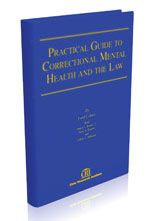Publication
Article
Psychiatric Times
Practical Guide to Correctional Mental Health and the Law
Author(s):
Detailed, thoughtful descriptions throughout a Practical Guide to Correctional Mental Health and the Law provide context and make this reference a realistic and practical resource.
If you were a psychiatrist in the 1950s, interested in providing mental health care to the most disadvantaged population with the most extreme forms of psychopathology, you would perhaps have chosen to work in a psychiatric hospital. Today, the career choice is in correctional mental health, and Practical Guide to Correctional Mental Health and the Law is recommended reading for those preparing for, or who have recently embarked on, this career. The book will almost certainly help readers understand the legal framework and the pragmatic characteristics of the demanding environment of a correctional facility.
The law informs mental health care in correctional settings in unique and challenging ways. This is the only population in the country with a constitutionally recognized right to health care-both general medicine and mental health-derived from the 8th and 14th Amendments.
The book reflects the pervasive nature of legal issues in mental health care in correctional settings. In many ways, it articulates what is often assumed or ignored in the health care community. Issues of paternalism, the right to treatment, confidentiality, and informed consent become far more central. Conditions of confinement are not a consideration for most clinicians, but these are routinely a concern in correctional settings. Cohen and colleagues bring these issues to life in a very readable, crisp, and engaging fashion.
Presented in 18 chapters, the 1-volume book is a convenient reworking and condensation of the original 2008 version. The book is clearly designed for function and ease of use; there is a detailed Table of Contents (12 pages) and an excellent Table of Cases (18 pages). The first chapter provides a comprehensive overview and a useful introduction to the legal framework of correctional mental health care and care delivery. My only caveat would be the relative prominence that is given to the Bureau of Justice Statistics report from 2006,1 with its flawed focus on symptoms of mental illness (versus prevalence rates of actual mental illness).
Topics specific to corrections are well described. Conditions of confinement, issues of safety and security, and the notions of dual agency of the clinician are presented within a proper context and with pragmatic guidance.
A critical topic extensively discussed is suicide risk management. While this is an intrinsic part of psychiatry in general, it looms even larger in correctional mental health care for a variety of reasons. First, the suicide rate in jail settings is elevated far above that in community settings. Acute anxiety, emotional distress, and detoxification challenges contribute to this elevated rate.
Second, virtually every suicide that occurs in a correctional facility results in a lawsuit. Understanding the context of care and recognizing the key factors that underlie suicide risk management are fundamental to correctional psychiatry. This text lays out the logic, the process, and the key components in a readable and very comprehensible way. The legal precedents can easily be followed.
This is not a dry legal text: consideration of the issues and concern for patient care are reflected in these pages. Detailed, thoughtful descriptions throughout a Practical Guide to Correctional Mental Health and the Law provide context and make this reference a realistic and practical resource. Readers will undoubtedly find what they are looking for, and they will do so quite expeditiously.
References:
Reference
1. James DJ, Glaze LE. Mental Health Problems of Prison and Jail Inmates. Washington, DC: Bureau of Justice Statistics, US Government Printing Office; 2006.






